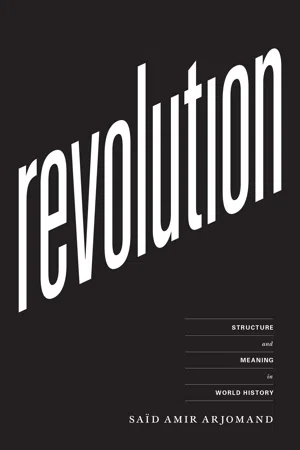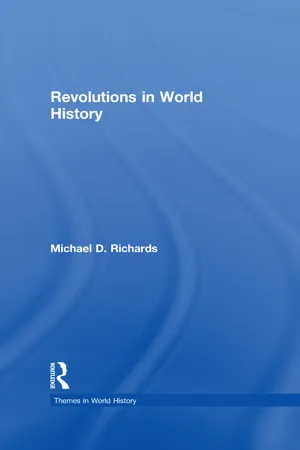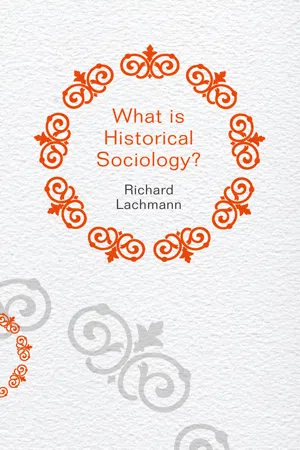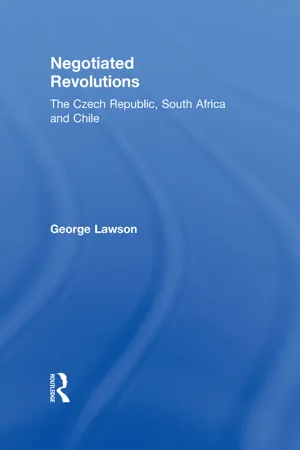History
Revolution
A revolution is a fundamental and often sudden change in the political, social, or economic structure of a society, typically resulting in a shift in power from one group to another. Revolutions can be sparked by various factors such as inequality, oppression, or a desire for greater freedom and rights. They often involve mass movements, protests, and sometimes armed conflict.
Written by Perlego with AI-assistance
Related key terms
Related key terms
1 of 4
Related key terms
1 of 3
10 Key excerpts on "Revolution"
- eBook - ePub
Revolution
Structure and Meaning in World History
- Saïd Amir Arjomand(Author)
- 2019(Publication Date)
- University of Chicago Press(Publisher)
The addition of the dimension of meaning to the conception of Revolution thus reopens the fundamental issues of definition and conceptualization of process as a typical sequence of events and their causation and consequences in comparative and historical sociology. More importantly, it raises the question of the significance of Revolutions as groundbreakers in world history.Definition and Architectonics of the Concept of Revolution
Revolution is a major instance of discontinuity in history that results in the replacement of one political order by another. It consists of a complex of meaningful events that transform the constitution of the structure of authority and political community through political mobilization and often acquire cultural significance. More formally, Revolution can be defined as a culturally significant and complex event that greatly increases the political mobilization of society and thereby results in major changes in its political organization or the structure of authority (the state, when the term applies) and/or its social base (i.e., the political community). Breaking this definition into its components and drawing out their methodological implications:- 1. Revolution is a complex event and its analysis requires historicization. This means that the analysis of the process of Revolution requires its periodization.
- 2. Revolution involves an intense political mobilization that subsides but results in a lasting transformation of the constitution of the political community and/or its form of government and structure of authority.
- 3. The implication of the above two points combined is that the analysis of Revolution as a process should distinguish between two overlapping stages: the Revolutionary power struggle among the contenders in the competition engendered by political mobilization and the constitutional politics of postRevolutionary political and social reconstruction. Each of these two phases of the process of Revolution needs to be historicized through the periodization of Revolution.
- 4. The outcome of the struggle for political order consists of changes in political and social organization. The enlargement of the political community and the changes in the structure of power are the two structural outcomes of Revolutions. They are subject, each and in combination, to a range of variation that can be divided heuristically into a typology.
- eBook - ePub
Revolutions
A Worldwide Introduction to Political and Social Change
- Stephen K. Sanderson(Author)
- 2015(Publication Date)
- Routledge(Publisher)
Chapter OneThe Nature of RevolutionsUnderstanding RevolutionsWhat is a Revolution? Wilbert Moore (1963), a well-known student of social change, thinks of Revolutions as a form of change that involves violence, that engages a large portion of the population, and that produces a transformation of the overall structure of government. John Dunn (1972) sees Revolutions as a form of change that is massive, violent, and rapid. Samuel Huntington (1968:264), in a definition that has been favorably endorsed by many, conceives of a Revolution as a “rapid, fundamental, and violent domestic change in the dominant values and myths of a society, in its political institutions, social structure, leadership, and government activity and policies.”A. S. Cohan (1975) lists six characteristics that Revolutions are typically thought to have: 1. Alteration of the basic values and myths of a society. 2. Alteration of the social structure. 3. Alteration of social institutions. 4. Changes in the structure of leadership, in terms of either the personnel of the elite or its class composition. 5. Nonlegal or illegal transfer of power. 6. Presence or dominance of violence in the actions leading a regime to collapse.Cohan suggests that most definitions of Revolution will include several of these attributes, and it is certainly possible for a definition to include them all. Cohan himself prefers to see the attributes “violence” and “value change” as least essential. His own definition of Revolution (1975:31) identifies it as “that process by which a radical alteration of a particular society occurs over a given time span. Such alteration would include (a) a change in the class composition of elites, (b) the elimination of previous political institutions and their replacement by others (or by none), or an alteration of the functions of these institutions, and (c) changes in the social structure which would be reflected in the class arrangements and/or the redistribution of resources and income.” This is certainly an all-encompassing definition, but it may be too restrictive to apply to every single event that some social analyst somewhere wants to call by the name Revolution - eBook - ePub
Political Violence, Crises and Revolutions (Routledge Revivals)
Theories and Research
- Ekkart Zimmermann(Author)
- 2013(Publication Date)
- Routledge(Publisher)
The latter aspect is noted by ARENDT (1964:27ff.), 26 although in a one-sided manner. It is her conviction that Revolutions must produce something new to merit the label “Revolution”: “Only where this pathos of novelty is present and where novelty is connected with the idea of freedom are we entitled to speak of Revolution” (ARENDT 1964:27). Yet, the class of Revolutionary objects is once again delineated in an unfruitful way, since Revolutions aimed at establishing values and some structures of a former epoch would not here be counted. 27 We must also criticize the idea of historicism inherent in this conception of Revolution. Is there indeed more freedom to be expected with new Revolutions looming on the horizon? 28 A central definitional criterion of Revolutions is that fundamental changes occur, no matter whether the particular conditions sought have already occurred in the past or not. The criterion of fundamental changes allows for distinguishing Revolutions from coups, e.g., from those coups carried out by political opponents with the mere promise to return to former (“better”) states. In the sense of our definition (cf. below), this type of coup cannot be treated as a Revolution. It would, however, qualify as Revolution (or at least as Revolutionary coup), if there were indeed fundamental changes in the prevailing political and social structures. HUNTINGTON's elaborate definition of Revolutions (HUNTINGTON 1968:264 with notable addenda from HUNTINGTON 1971a:5 in brackets) 29 may be helpful in summarizing part of the preceding discussion: A Revolution is a rapid, fundamental, and violent domestic change in the dominant values [concepts of legitimacy] and myths of a society, in its political institutions, social structure [economic relationships], leadership, and government activity and policies [in short, the demolition of the existing social, economic, and political order and the effort to substitute an entirely new one] - eBook - ePub
- Michael D. Richards(Author)
- 2004(Publication Date)
- Routledge(Publisher)
Chapter 7
Revolutions in world history
The title of Chapter 1 , “Bringing Revolutions back into history,” was meant to suggest two basic ideas. One idea asserts that Revolutions had histories and that approaching them with historical methods would pay sizeable dividends. This is not to say that political scientists, sociologists, and others from the social sciences had nothing to contribute, only to indicate that we must not confine ourselves to typologies, etiologies, and overarching patterns. A second, far larger idea involved pointing out the importance of Revolutions in world history over the past four centuries, at least since the British Revolution of the seventeenth century. Revolutions are not diseases that had to run their course or disruptions to a state of desired equilibrium that had to be dealt with before the continuity of history might be resumed. They are integral parts of the historical record, one way of solving problems, one way of deciding which groups pay what price for whatever happens.To put the matter somewhat differently, the phenomenon of Revolution has been and likely will continue to be a potent factor in shaping the raw material of history. From that it follows that any attempt to set down the historical record that regards Revolution as an interruption to the flow of history or an anomaly will be a flawed attempt. Revolution as we have come to understand it in the last few centuries has done more than contribute drama and bloodshed to history. It has been a major part of that history, in the same way as industrialization or urbanization. It has also played a major role in the sense that human beings often acted in certain ways to pre-empt it or to dampen down situations that looked likely to flare up.Revolution as politics (I)
Politics has always included the threat or use of violence and force. From the seventeenth century to the present, in an increasingly self-conscious way, political actors came to recognize Revolution as another way to doing politics. - eBook - ePub
- William Outhwaite, Stephen Turner, William Outhwaite, Stephen Turner(Authors)
- 2017(Publication Date)
- SAGE Publications Ltd(Publisher)
Revolution in such context is the Industrial Revolution, or the Commercial Revolution. Note that such Revolutions also fit the ‘slow Revolution’ definition of Tocqueville. A similar example is the Digital Revolution.The statement regarding Tocqueville is again based on a secondary source.)Having duly noted these attempts to embellish on the ‘Aristotelian’ definition of Revolutions, the article turns to its contemporary reformulations which do not attempt any embellishments, but preserve and transmit it intact. To this effect it cites two preeminent authorities on the subject specifically in sociology: Jeff Goodwin and Jack Goldstone. ‘Jeff Goodwin', it says,gives two definitions of a Revolution. A broad one, where Revolution is any and all instances in which a state or a political regime is overthrown and thereby transformed by a popular movement in an irregular, extraconstitutional and/or violent fashion and a narrow one, in which Revolutions entail not only mass mobilization and regime change, but also more or less rapid and fundamental social, economic and/or cultural change, during or soon after the struggle for state power. Jack Goldstone defines them as an effort to transform the political institutions and the justifications for political authority in society, accompanied by formal or informal mass mobilization and noninstitutionalized actions that undermine authorities.The reader is referred to the primary sources dated 2001. By that time, according to Jack Goldstone, it is possible to distinguish four generations in academic literature on Revolutions, or ‘Revolutionary theory', much of it written by sociologists.‘Revolutionary theory’ in this context refers to explanations of why Revolutions happen. The Wikipedia article provides a long list of the leading theorists, classifying them by generation and in accordance with the broader theory from which they derive their explanations and variables they emphasize. Generations roughly correspond to birth cohorts and replace each other as they usually do in the social sciences, with students arguing against their teachers and taking over, the first one influential through the first half of the twentieth century, the second – students of the first generation – through 1970s, the third one – students of the second generation – through early 1990s. Given how broad the definition of a Revolution is, the list of cases these three first generations considered appears remarkably limited. The theories ‘tended to concentrate on four classic cases – famous and uncontroversial examples that fit virtually all definitions of Revolutions, such as the Glorious Revolution (1688), the French Revolution (1789–1799), the Russian Revolution of 1917 and the Chinese Revolution (also known as the Chinese Civil War) (1927–1949)'. (The French, Russian, and Chinese Revolutions were certainly an object of very much theorizing in political sociology and political science; not so the Glorious Revolution, which, it must be noted, does not fit the accepted definition, since the English population did not rise in revolt. To which extent the Chinese Revolution, which had arguably begun in 1911, fits it depends on what one defines as ‘a short period of time'.) The fourth generation of Revolutionary theorists, in distinction, is responding not only to the perceived shortcomings of their teachers’ work, but to the changed Revolutionary landscape. Theories of the three previous generations, explains the article, - eBook - ePub
Thinking Revolution Through Film
On Audiovisual Stagings of Political Change
- Hanno Berger(Author)
- 2022(Publication Date)
- De Gruyter(Publisher)
This in turn enabled for the first time the concept of ‘history’: “The modern concept of Revolution cannot be understood without its interdependence with the term ‘history,’ which emerged simultaneously […].” 14 In antiquity, political change was conceived in the framework of a circular return of conditions 15 and was part of what Koselleck calls a transhistorical concept. This transhistorical notion of political change did not allow for any development or profound change of the existing order; instead, it suspended all political positions. By contrast, Koselleck characterizes the modern idea of Revolution as metahistorical and describes it as follows: As with the German concept of Geschichte, which in the form of “history pure and simple” contained within itself the possibilities of all individual histories, Revolution congealed into a collective singular which appeared to unite within itself the course of all individual Revolutions. Hence, Revolution became a metahistorical concept, completely separated, however, from its naturalistic origin and henceforth charged with ordering historically recurrent convulsive experiences. In other words, Revolution assumes a transcendental significance; it becomes a regulative principle of knowledge, as well as of the actions of all those drawn into Revolution. 16 In contrast to a transhistorical concept, in which fundamental changes and developments of human life are unthinkable, and instead disappear into monotonous repetition, but also in contrast to a singular event with no consequences, the metahistorical concept that crystallized in modernity into the collective singular ‘Revolution’ is a “historicophilosophical concept, based on a perspective which displayed a constant and steady direction.” 17 The modern concept of Revolution was what made it possible to reflect on the development of humanity and human life from a perspective that extends beyond cyclical repetition - eBook - ePub
- Richard Lachmann(Author)
- 2013(Publication Date)
- Polity(Publisher)
3 Revolutions and Social MovementsSome events are more consequential than others. Revolutions are among the most momentous in world history. How can we study such epochal historical moments? How do we explain why social actors decide to take great risks to challenge the powerful at some rare times, when for the most part people resign themselves to the existing social order? As we see how some historical sociologists have sought to answer these questions, we will be able to explore methods for addressing the role of human agency in historical change.Most people through most of human history have been poor, miserable, and exploited, and they have been unhappy about their condition. Misery is not enough to create a social movement or to spark a Revolution. As Barrington Moore (1978, p. 161) puts it, “in the human repertoire of responses to deprivation and injustice an aggressive counterattack is scarcely the one to anticipate as automatic and somehow ‘natural.’ ” If we want to explain why Revolutions and social movements occur and how they matter, we need to work our way through three distinct steps.- First, we must identify moments when Revolutions or social movements occurred. This is partly a problem of definition, just as it is with explaining the origins of capitalism. As with the origins of capitalism, we can cut through inconclusive debates by focusing on identifying moments of historical change. In the case of Revolutions, we need to find occasions when not just rulers were overthrown but the form of rule itself was transformed. In the case of social movements, we need to find moments when popular groups went beyond making demands and protesting and actually won significant concessions from those against whom they mobilized.
- Second
- eBook - ePub
History and Revolution
Refuting Revisionism
- Jim Wolfreys, Mike Haynes, Jim Wolfreys, Mike Haynes(Authors)
- 2020(Publication Date)
- Verso(Publisher)
What follows is divided into two sections. The opening chapters deal with the English, French and Russian Revolutions and their treatment by revisionist historiography. The second half of the book examines some of the debates and themes arising from attempts to revise downwards the significance of Revolution’s role in history. The rebuttal of these readings is based on a reassertion of the importance of Revolution in human development and a recasting of the role of the political, rejecting the revisionist conception of ideology as an autonomous and irreducible sphere imposed by demagogues on society from without. Politics emerges as a realm of choices and uncertainties resolved through struggle, neither the mere product of economic development, nor completely detached from social conflict. Such an understanding means moving beyond the narrow and prescriptive conception of bourgeois Revolution which sometimes surfaces in the work of traditional social historians, and which takes on a caricatural role in revisionist denigrations of social history. This involves grasping the course of economic and social progress as uneven, with remnants of previous forms of development co-existing with new forms of social organization. This in turn, as Geoff Kennedy argues in his examination of radicalism in the English Revolution, requires seeing the transition from feudalism to capitalism as something other than a linear, teleological process. Politics interacts with this broader framework not simply by postulating some abstract utopian future, but develops in response to a shifting and unpredictable present. Attempts to conceive of ideology as nothing more than the rationalization of material grievances is therefore rejected as akin to the reductionism denounced so loudly and often by the revisionists themselves. More importantly revisionism is shown to be unable to explain why millions are moved to act in defence of political causes, or why specific political currents emerge.The role played by Revolution with regard to economic transition is taken up by Jim Wolfreys in an assessment of the gap between intentions and actions in the French Revolution. The tumultuous leaps in consciousness experienced by those caught up in Revolution are viewed not so much as instances of hubris, of Revolutionary arrogance, but as evidence of the profoundly conservative attachment to existing institutions and values which characterizes periods of comparative stability. Such leaps, in other words, are a feature of the jagged course of historical development. Tensions ripple beneath the apparently calm surface of society before rending it apart. Revisionism, by contrast, may be seen as a form of quietism, disparaging the Revolutionary quest for equality as a demagogic refusal to respect the limits imposed by liberal democracy in the pursuit of social stability. These limits however, as Florence Gauthier demonstrates, could only be imposed by breaking with the liberalism of reciprocal rights that flourished during the French Revolution, and which conceived a far more extensive set of political and social freedoms than those which survived it. In addressing this question Gauthier focuses on one of several major blind spots in the revisionist case – the issue of slavery. Its abolition may have been one of the greatest achievements of the Revolutionary period, but it merits not even a passing reference in Simon Schama’s Citizens. Neither do the protagonists of slave liberation, such as Toussaint l’Ouverture, find places in Furet and Ozouf’s hefty Dictionary of the Revolution - eBook - ePub
- Mehran Kamrava(Author)
- 2012(Publication Date)
- Routledge(Publisher)
Revolutions are clearly multifaceted phenomena arising out of the interplay of an array of diverse political, economic and social developments. They are, in the first place, products of skewed political development, of inherently unstable processes through which the body politic passes, voluntarily or involuntarily, on its way towards becoming a modern polity. Revolutions are, in essence, violent struggles aimed at achieving a fuller and more developed political establishment that is supposedly more capable than the incumbent state of delivering popularly desired goods and services. This struggle is an eminently political one, with its genesis, direction, scope and magnitude all dependent on the specific political configurations that happen to prevail at the time. However, the contextual environment within which the wilful leaders and the receptive audience of this struggle emerge is heavily influenced by dynamics which may be fundamentally apolitical, particularly those that are social and cultural or economic in nature. The polarising effects of this contextual environment are all the more accented in the developing world, where industrial development, rapid urbanisation and intense social change simultaneously take place at dizzying pace and breed an atmosphere that is highly conducive to the eruption of full-blown Revolutions or at least to the appearance of Revolutionary movements.Where Revolutions lead is a question largely dependent on whether they are more planned in genesis and execution or involve greater spontaneity. Planned Revolutions are based largely on premeditated programmes devised by wilful Revolutionaries who know precisely what they want and have a clear idea of the ways and means to achieve their goals. Their efforts are undertaken with clear goals in mind and, if successful, there is often little disparity between their previously proclaimed goals – apart, of course, from their boisterous and at times manipulative and false promises – and newly initiated policies. Spontaneous Revolutions, on the other hand, are more often the outcome of developments that at first look hardly Revolutionary. They involve neither formulated programmes nor planned initiatives. Their leaders emerge relatively late, and the ultimate goals of those leaders are formed and pronounced even later. The Revolution’s goals and ideals are initially elusive at best, summed up in dogmatic slogans and vague promises. Each cadre of leaders promises such appealing alternatives as democracy and equality, principles that are left open to differing interpretations once it is time for their implementation. In these instances the ideals and purposes of Revolutions often appear vastly contradictory to their eventual outcomes, a contradiction which is more the result of the inherent looseness of the Revolutionary process itself than the sinister manipulation of Revolutionary turn-faces. - eBook - ePub
Negotiated Revolutions
The Czech Republic, South Africa and Chile
- George Lawson(Author)
- 2017(Publication Date)
- Routledge(Publisher)
That they did not have recourse to violence was the result of willed action within a context that enabled the relatively peaceful negotiation of power rather than prompting violent confrontation. Thus the concept of force was a central part of the process of negotiated Revolution and violence, albeit latent, was present in all three cases. 22 Revolution is a constant feature of world history: a study of its etymology would have to include the Greek concepts of epanastasis (revolt) and neoterismos (innovation), the Arabic terms inqilab (to rotate) and thaura (to revolt), the notions of mered (rebellion), kom (uprising), marah (revolt) and kesher (plot) in classical Hebrew, and the Chinese word ge-ming (change of life, fate or destiny). 23 Over the last two hundred years, deriving in part from the work of Montesquieu, Voltaire and Rousseau, the concept of Revolution has become more circumscribed, assuming a narrow meaning as a radical break from past arrangements. In this way, the English Civil War of the 1640s was reinterpreted as a Revolution during the eighteenth-century, as was the Revolt of the Netherlands and, later on, the American War of Independence. After the French Revolution, the concept of Revolution took on a kind of transcendental, metahistorical tilt that universalized, naturalized and ultimately, mythologized, the Revolutionary experience. 24 Rationality, progress and liberty became inexorably tied to the concept of Revolution alongside the idea of total, inevitable change. The teleological view of history contained within the modem concept of Revolution saw Revolution as a necessary step on the march towards the ultimate kingdom of ends. Each generation of Revolutionary scholarship subscribed to this essentialist view, in a sense buying into the romantic fantasies of Revolutionaries themselves. Rather than looking for similarities in Revolutionary ideology, advocates fetishized Revolutionary rhetoric
Index pages curate the most relevant extracts from our library of academic textbooks. They’ve been created using an in-house natural language model (NLM), each adding context and meaning to key research topics.
Explore more topic indexes
Explore more topic indexes
1 of 6
Explore more topic indexes
1 of 4









